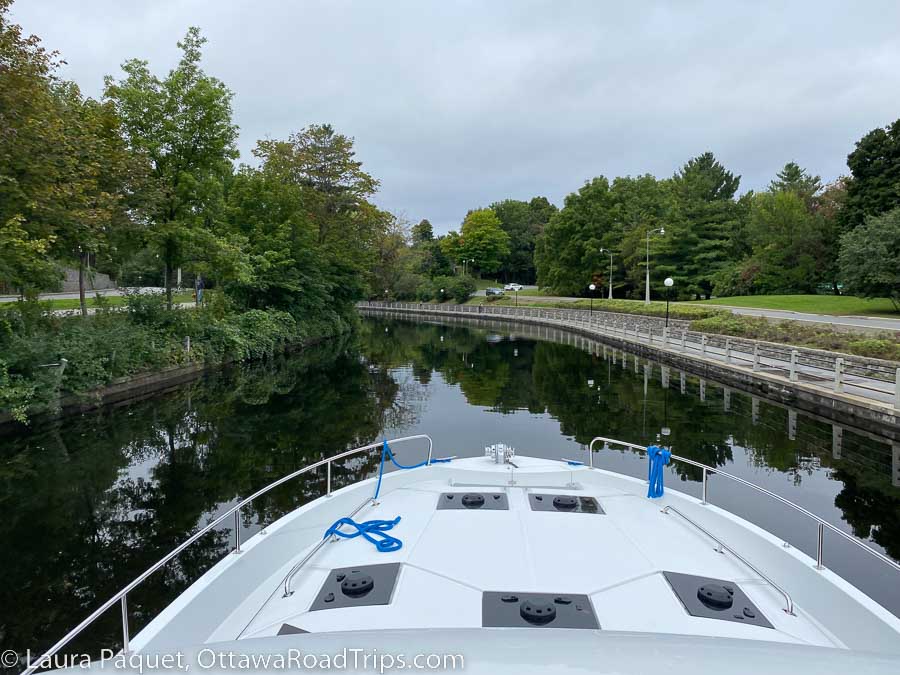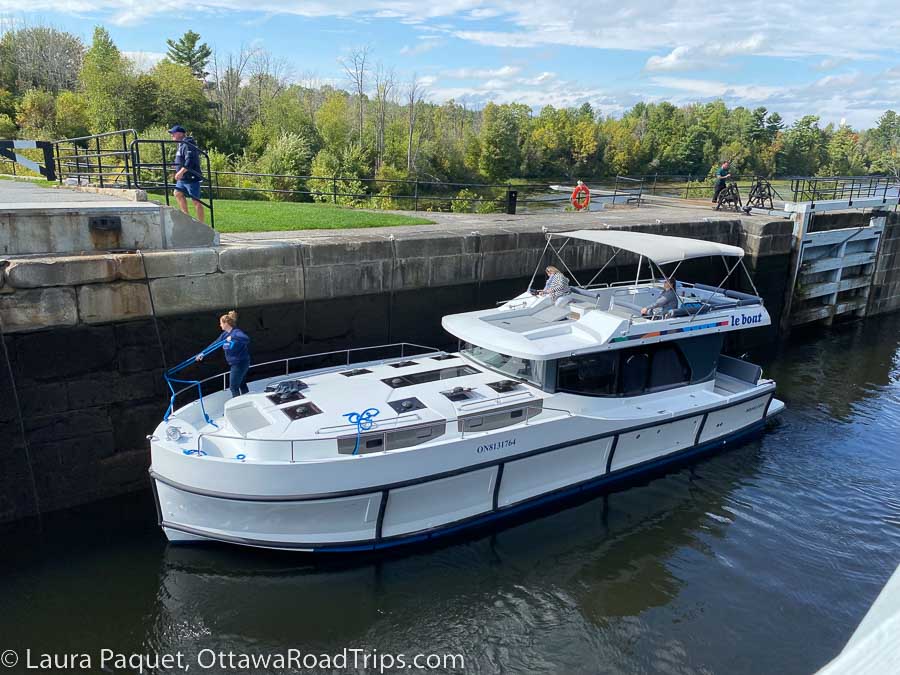Disclosure: I took this trip for free as a guest of Le Boat and Parks Canada, neither of which have reviewed or approved this post. All opinions are my own.
A recent day trip on a posh Le Boat houseboat gave me a whole new perspective on the Rideau Canal and Ottawa, which isn’t easy to do.
After all—not to toot my own horn, but here we go—I’ve been writing about Ottawa since shortly after I moved here in the 1980s. For most of the time since, I’ve lived within a 15-minute walk of the Rideau Canal. I’ve walked and cycled beside the canal. I’ve paddled and skated on it. I’ve driven over it and taken the train over it. I’ve seen it from a plane and a hot air balloon. You get my drift.
So I was very pleasantly surprised to discover all sorts of things I didn’t know about the canal—and lots of new viewpoints—on a recent day trip with Le Boat from downtown Ottawa to Manotick.
What is Le Boat, and where can it take me on the Rideau Canal?

Le Boat is a British-based company specializing in canal houseboat rentals. All of its other destinations are in Europe; France and Ireland are two popular countries. Le Boat opened its first (and so far, only) base in Smiths Falls, an hour’s drive southwest of Ottawa, in 2018.
My day trip was just a taste of the whole Le Boat experience and a somewhat unusual one, as trips normally start from the Smiths Falls base.
The Rideau Canal stretches 202 kilometres from Ottawa to Kingston, Ontario, but you couldn’t do that whole round trip with Le Boat unless you rented a houseboat for a couple of weeks. It will take you about 4.5 hours to putter from Smiths Falls to Perth, for instance, and about six hours to cruise from Smiths Falls to Merrickville. And you’d probably want the boat for a week if you planned to take it north from Smiths Falls to Ottawa and back, or on a roundtrip south to the Rideau Lakes.
Whatever itinerary you choose, leave yourself lots of time to explore the communities along the way or just to soak up the sun on shore.
Boarding Le Boat in downtown Ottawa

My day trip began when I stepped aboard one of Le Boat’s Horizon 5 houseboats, moored on the canal opposite the Westin Hotel. The Horizon 5 is the biggest and fanciest of Le Boat’s many models, with five sleeping cabins, a well-equipped galley kitchen/living area, an upper covered deck and a big sundeck, where you can watch the world go by.
My travelling companions for the day were Lisa Mclean from Le Boat, Guy Thériault and Eric Magnan from Parks Canada, and Barbara King from Watersheds Canada.
Fuelled up with coffee and tea, we (well, the people who knew what they were doing—i.e., not me) untied the mooring ropes and piloted us away from the canal bank. And we were off!

The first things I had to get used to as we glided along the canal were the envious glances of people on shore. That wasn’t something I’ve ever had to contend with while showcasing my skating and kayaking skills on the canal.
It didn’t take long for me to channel my inner Jackie Onassis, though. By the time we rounded the first bend in the canal and headed toward the Pretoria Bridge, I was lounging on the sundeck as though I’d been born and raised in a New England resort town.
The Pretoria Bridge looks different from the water

Sailing under the Pretoria Bridge was one of my first indications that this trip would provide a new look at canal life. I’ll admit that until this trip, my reaction to watching boats travel this stretch of the canal had been a mixture of fascination (“Wow, wouldn’t that be cool?”) mixed with agitation (“Yikes, here comes a boat, and I really need to cross the bridge so I’m not late for my dentist appointment!”) and outright annoyance (“Oh, crap, the bell is dinging and the gates are coming down, so I’m going to spend the next 10 minutes sitting on Colonel By Drive while some rich folks cruise by on their yacht.”).
I’m here to tell you that it’s a whole new world when you’re the rich person on the yacht—even if you’re just pretending to be Jackie O for a day.
First of all, being on a larger boat (as opposed to paddling a kayak) gives you new insight into how the bridges and locks along the Rideau Canal work. I’d never really thought much about why the road in the middle of the Pretoria Bridge rises when a boat approaches. If asked, I’d probably have answered that the vertical-lift bridge had some kind of automatic boat-detecting system, which flipped a switch and made the bridge go up—kind of like the entrance doors at Loblaws.
But I would have been wrong. The people in the boat have to call the bridge master, who has an office on the bridge and does all the work to make the structure open and close.
So, again, I watched like the pampered passenger I was as Guy and Lisa communicated with the bridge master. Soon, the bells started to clang, the bridge rose, and we sailed below it as cars piled up on Colonel By Drive and the Queen Elizabeth Driveway. I feel your pain, I wanted to call to the drivers as we glided by.
Through the Glebe to Hogs Back Locks

Soon, Barbara—the other newbie Le Boater on the trip—took the wheel and piloted us through one of the narrowest parts of the whole canal. That’s the stretch between the Glebe and Old Ottawa South, from Bank Street to Bronson Avenue.
The boat’s top possible speed is 10km/h, which sounds slow, but houseboating is all about taking life easy and enjoying the view. As we skirted the southern edge of Dows Lake, we paused to watch a flock of geese honk their way southward.
As we sailed past Carleton University, I pointed out to the others the window of my one-time dorm room (Grenville House 206, if I remember correctly). Then it was time to go through the Hartwell Locks, wedged across the canal between Carleton and the Central Experimental Farm.

To be completely honest, I’ve had the workings of canal locks explained to me repeatedly. However, my complete ignorance of the basic principles of engineering, hydraulics and physics hinder my comprehension every time.
Fortunately, the great thing about cruising the Rideau Canal is you don’t really need to understand how locks work. I mean, you don’t have to understand the mechanics of traffic lights to drive a car, right?
If I’d actually rented this boat for a multi-day trip, the folks from Le Boat would have taught me and my fellow passengers all we would need to know to pilot the boat safely, from how to use the boat’s two thrusters to manoeuvre it close to shore to how to knot the ropes when securing the boat inside a lock. We would also learn the basics of all the gadgets on the boat, such as the plumbing, electrical and propulsion systems.

It all sounds complicated, but it really isn’t. As we entered the lock and it filled with water, the boat rose smoothly. Once the lock had raised us 6.5 metres (21.5 feet), the wooden gates opened and we continued to glide on our merry way.
Soon, we had passed through the Hogs Back Locks—which raised the boat another 4.4 metres (14.5 feet)—and were cruising past Mooney’s Bay. From this far out on the water, the beach actually looks a bit tropical.
How the other half lives, south of Mooney’s Bay
Lisa and Barbara asked if I’d like to try a turn at the wheel, but I wasn’t quite ready yet—partly because I wanted to observe the process a bit more first, but mainly because I was too busy ogling some of the houses we passed by.
I did know there were a few ritzy streets off Riverside Drive, but I’d never had any reason to drive down them. But now, I openly gaped at the waterfronts of what could only be called mansions. These were like cottages on steroids, with beautiful decks and huge windows, Jetskis and fire tables, gazebos and gardens and pools. At least one house had its own tennis court.
I had no idea that people were living like Jay Gatsby a stone’s throw from South Keys.
It’s weirdly hard to get your bearings from the water. I often had to ask my fellow passengers where exactly we were, only to discover that streets and landmarks I know well were just a few metres away. At least I realized when we were approaching the airport, as several planes roared overhead.
By the time we’d gone through the Black Rapids Lockstation and sailed under the Vimy Memorial Bridge—another unusual view of a local landmark—I was feeling more ready to pilot the boat.

Lisa showed me how the GPS worked and instructed me in the basics of channel markers, telling me which ones to keep on my left and which on my right to avoid piloting the boat into shallow or rocky waters. She also warned me that the wind—which had been a bit blustery all morning—is much more of a factor when guiding a boat than when driving a car. I needed to make regular corrections to keep the breeze from blowing us off course. But, truly, it wasn’t hard. And if I could do it, anyone can do it.
And, in case you’re wondering, the boat has bumpers all around the edges to reduce the possible damage if you steer the boat into something by accident. Even so, I was happy to leave the tricky manoeuvring to others.
Learning how to open a heritage swing bridge
After about three laid-back hours of cruising, we reached the Long Island Locks on the north side of Manotick. And here’s where travelling as a reporter had an unexpected perk: The Parks Canada folks let me open the swing bridge.
It was surprisingly easy; those 19th-century engineers knew what they were doing. The lockmaster fitted a big metal thingamabob that looked like a giant tire iron onto a pin under the deck of the bridge. Then, I had to walk in circles while pushing or pulling the metal handle to open the bridge.
After a bit of effort to start things moving, the task was really easy. The bridge swung open so our boat could pass through, then I closed it again and hopped back on board.

We sailed to the far side of Manotick while munching on the lovely picnic that Lisa and Barbara had packed—sandwich fixings, guacamole, veggies and drinks. We ate on board, but there are picnic tables at most lockstations, which would be scenic stops, too.
All too soon, it was time to turn the Horizon 5 around and putter back to downtown Ottawa. We were tying up opposite the Westin by about 4:30pm.
What equipment will you find aboard Le Boat’s Horizon 5?
The Horizon 5’s galley/living area is well equipped with a stove, microwave, sink, small TV and decent-sized fridge. The galley table seats about eight, and the benches convert to two single beds, if you need them. There’s also a second outdoor table with seating on the upper covered outdoor deck, and a barbecue hotplate on the outdoor lower deck.

As one of the largest Le Boat models, the Horizon 5 can sleep 12 people, if you count the galley beds. I suspect those would be for kids, while the adults would snag one of the five cabins, each with its own loo, complete with sink, shower and toilet. (I tested the water pressure in one of the showers and can report that it was quite good. And the toilets work on similar principles—and with the same disconcerting rumble—as the toilets on planes, trains and buses.)
The largest cabin, in the bow of the boat, is the roomiest and has a double bed. The other four have singles that can be pushed together to form doubles. The cabins are admittedly cosy; this is not a vacation for anyone with claustrophobia issues. And if you’re travelling with a lot of gear, Le Boat advises booking a boat with one more cabin than you need for sleeping, as that will give you a place to stash your stuff. There are USB ports in all of the cabins, as well as in the galley and on the upper deck.

In terms of navigation, you can pilot the boat from the covered outdoor upper deck or from a second station in the galley (which would be very handy on rainy days).
Boaters can rent all sorts of additional goodies, such as bikes, a barbecue, kayaks, standup paddleboards and even a wi-fi router. Also, dogs are welcome, for an extra fee.
Bedding is provided, but otherwise equipping yourself for a Le Boat houseboat vacation is much like prepping for a camping or rental cottage holiday. You’ll need to bring essentials such as toilet paper, soap, shampoo, garbage bags, beach towels, food, drinks and the like, or pay Le Boat to supply them.
How much does Le Boat cost?
OK, now we’re getting down to the nitty gritty. If you want to live like Jackie O for a few days, a week or more, you may have to face some heiress-style prices. The rates below are just for the houseboat, without any of the optional rentals and supplies mentioned above. They also don’t include insurance or fuel.

The Horizon 5 is one of the most expensive rental boats in the Le Boat fleet, but you can save a bit if you choose to rent in the shoulder seasons (basically, late spring and early fall). Prices fluctuate, but you can expect to pay around $4,000 to rent a Horizon 5 for a week in October, with the fee rising to the neighbourhood of $9,000 in July or August.
Before you have a stroke, remember that you’ll be splitting this payment with up to 12 people (but, let’s be honest, some of those people will probably be kids, so it’s probably better think of it on a per-family rather than per-person basis).
Are those prices too posh for your pocketbook? Yeah, me too. However, don’t despair! Le Boat has smaller Horizon houseboats that can get you out on the canal in shoulder season for prices starting at about $2,600 a week for a model that sleeps five.
For more information, check out Le Boat’s Rideau Canal webpage. Bon voyage!
Looking for more tips on things to see and do in Eastern Ontario, the Outaouais, northern New York state and beyond? Subscribe to my free weekly newsletter or order a copy of my book, Ottawa Road Trips: Your Weekend Getaway Guide.
As the owner of Ottawa Road Trips, I acknowledge that I live on, work in and travel through the unceded, unsurrendered territory of the Algonquin Anishinaabeg Nation. I am grateful to have the opportunity to be present on this land. Ottawa Road Trips supports Water First, a non-profit organization that helps address water challenges in Indigenous communities in Canada through education, training and meaningful collaboration.
